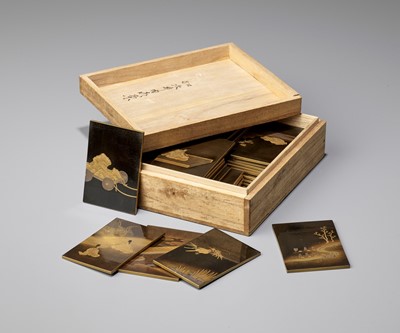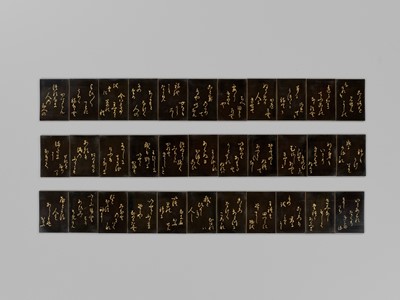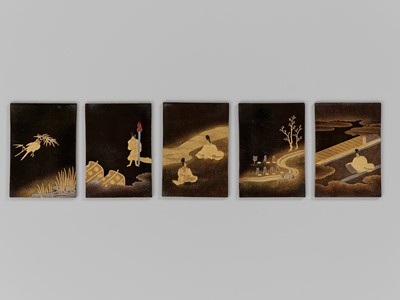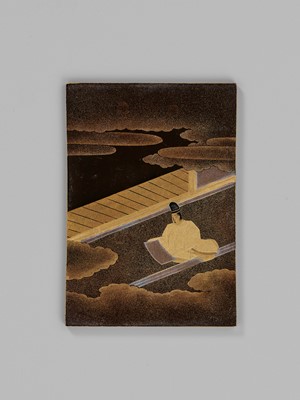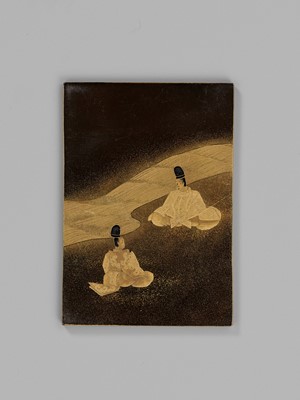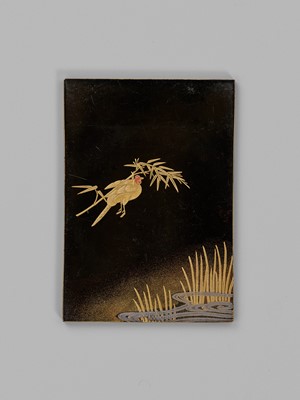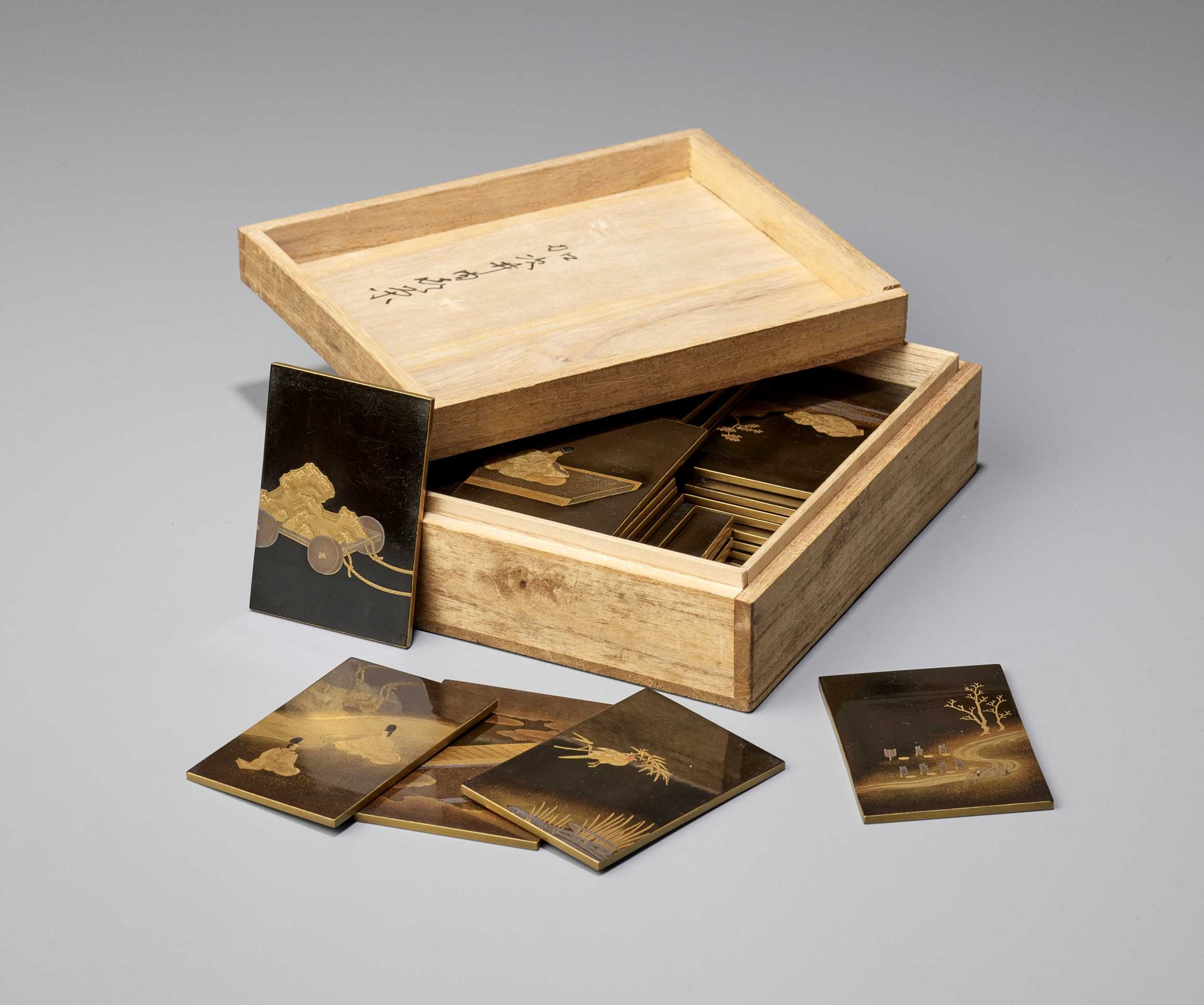3rd Dec, 2021 13:00
Fine Japanese Art
158
A VERY RARE SET OF 33 LACQUER KARUTA (PLAYING CARDS) BASED ON THE TALES OF ISE
Sold for €5,056
including Buyer's Premium
Japan, 19th century, Edo period (1615-1868)
Each card of rectangular form with a roiro ground finely decorated in gold and iro-e takamaki-e, hiramaki-e, and e-nashiji, depicting a scene from a chapter of Ise monogatari (The Tales of Ise) to one side and either kami no ku (the first part) or shimo no ku (the second part) of a poem from the corresponding chapter on the other, the chapters including nos. 13, 34, 40, 65, and 124.
SIZE 7.5 x 5.2 cm (each card)
Condition: Very good condition with only very minor surface wear.
Provenance: British private collection.
With a wood storage box, inscribed to the cover.
A popular type of card game in Japan involved matching the opening and closing lines of famous poems written on two separate cards. Players would certainly have been familiar with the poems, even knowing them from memory. Whoever matched the most pairs of verses won the game. Commonly such playing cards were made of paper, making these extremely finely lacquered karuta exceedingly rare.
The Tales of Ise (Ise monogatari) is a Japanese uta monogatari, or collection of waka poems and associated narratives, dating from the Heian period. The current version collects 125 sections, with each combining poems and prose, giving a total of 209 poems in most versions. Theories vary as to the identity of the author, with some suggesting that it began as an autobiographical work by Ariwara no Narihira and others speculating that the stylistic similarities to passages in the Kokin Wakashū point to Ki no Tsurayuki as the author. Others have, based on the title of the work, guessed that it may have been composed by the poet Ise, but this is generally taken as unlikely, as none of the other known works of this period use the names of their authors as their principal titles.
The narrative makes little attempt to link the sections, but introduces or provides a scene for the composition of the poem. A rough chronology of the central character's life is established through the sections, from the 'young man who came of age' in section 1, through numerous adventures and loves, to the man who fell gravely ill and 'knew in his heart that he was to die', in section 125. This neither produces a traditional biography, nor even a traditional plot, as seen from a Western perspective.
Japan, 19th century, Edo period (1615-1868)
Each card of rectangular form with a roiro ground finely decorated in gold and iro-e takamaki-e, hiramaki-e, and e-nashiji, depicting a scene from a chapter of Ise monogatari (The Tales of Ise) to one side and either kami no ku (the first part) or shimo no ku (the second part) of a poem from the corresponding chapter on the other, the chapters including nos. 13, 34, 40, 65, and 124.
SIZE 7.5 x 5.2 cm (each card)
Condition: Very good condition with only very minor surface wear.
Provenance: British private collection.
With a wood storage box, inscribed to the cover.
A popular type of card game in Japan involved matching the opening and closing lines of famous poems written on two separate cards. Players would certainly have been familiar with the poems, even knowing them from memory. Whoever matched the most pairs of verses won the game. Commonly such playing cards were made of paper, making these extremely finely lacquered karuta exceedingly rare.
The Tales of Ise (Ise monogatari) is a Japanese uta monogatari, or collection of waka poems and associated narratives, dating from the Heian period. The current version collects 125 sections, with each combining poems and prose, giving a total of 209 poems in most versions. Theories vary as to the identity of the author, with some suggesting that it began as an autobiographical work by Ariwara no Narihira and others speculating that the stylistic similarities to passages in the Kokin Wakashū point to Ki no Tsurayuki as the author. Others have, based on the title of the work, guessed that it may have been composed by the poet Ise, but this is generally taken as unlikely, as none of the other known works of this period use the names of their authors as their principal titles.
The narrative makes little attempt to link the sections, but introduces or provides a scene for the composition of the poem. A rough chronology of the central character's life is established through the sections, from the 'young man who came of age' in section 1, through numerous adventures and loves, to the man who fell gravely ill and 'knew in his heart that he was to die', in section 125. This neither produces a traditional biography, nor even a traditional plot, as seen from a Western perspective.
Zacke Live Online Bidding
Our online bidding platform makes it easier than ever to bid in our auctions! When you bid through our website, you can take advantage of our premium buyer's terms without incurring any additional online bidding surcharges.
To bid live online, you'll need to create an online account. Once your account is created and your identity is verified, you can register to bid in an auction up to 12 hours before the auction begins.
Intended Spend and Bid Limits
When you register to bid in an online auction, you will need to share your intended maximum spending budget for the auction. We will then review your intended spend and set a bid limit for you. Once you have pre-registered for a live online auction, you can see your intended spend and bid limit by going to 'Account Settings' and clicking on 'Live Bidding Registrations'.
Your bid limit will be the maximum amount you can bid during the auction. Your bid limit is for the hammer price and is not affected by the buyer’s premium and VAT. For example, if you have a bid limit of €1,000 and place two winning bids for €300 and €200, then you will only be able to bid €500 for the rest of the auction. If you try to place a bid that is higher than €500, you will not be able to do so.
Online Absentee and Telephone Bids
You can now leave absentee and telephone bids on our website!
Absentee Bidding
Once you've created an account and your identity is verified, you can leave your absentee bid directly on the lot page. We will contact you when your bids have been confirmed.
Telephone Bidding
Once you've created an account and your identity is verified, you can leave telephone bids online. We will contact you when your bids have been confirmed.
Classic Absentee and Telephone Bidding Form
You can still submit absentee and telephone bids by email or fax if you prefer. Simply fill out the Absentee Bidding/Telephone bidding form and return it to us by email at office@zacke.at or by fax at +43 (1) 532 04 52 20. You can download the PDF from our Upcoming Auctions page.
How-To Guides
How to Create Your Personal Zacke Account
How to Register to Bid on Zacke Live
How to Leave Absentee Bids Online
How to Leave Telephone Bids Online
中文版本的操作指南
创建新账号
注册Zacke Live在线直播竞拍(免平台费)
缺席投标和电话投标
Third-Party Bidding
We partner with best-in-class third-party partners to make it easy for you to bid online in the channel of your choice. Please note that if you bid with one of our third-party online partners, then there will be a live bidding surcharge on top of your final purchase price. You can find all of our fees here. Here's a full list of our third-party partners:
- 51 Bid Live
- EpaiLive
- ArtFoxLive
- Invaluable
- LiveAuctioneers
- the-saleroom
- lot-tissimo
- Drouot
Please note that we place different auctions on different platforms. For example, in general, we only place Chinese art auctions on 51 Bid Live.
Bidding in Person
You must register to bid in person and will be assigned a paddle at the auction. Please contact us at office@zacke.at or +43 (1) 532 04 52 for the latest local health and safety guidelines.
